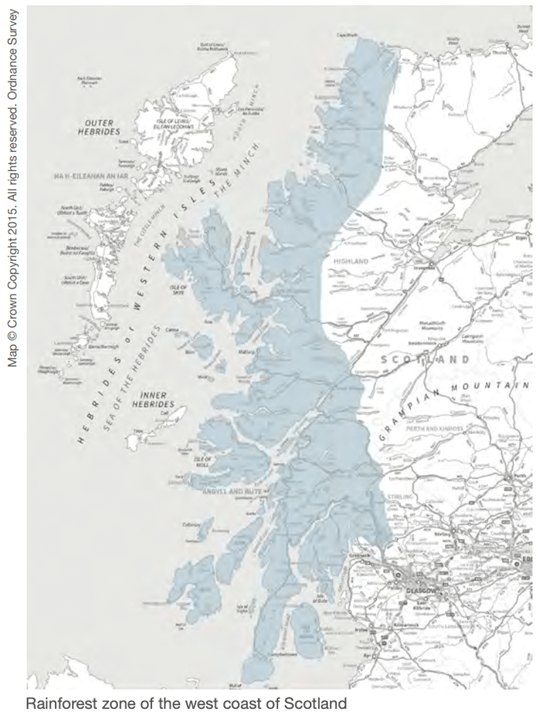Rhododendron ponticum is one of the main threats to Scotland’s rainforest, alongside overgrazing by deer and sheep. An invasive non-native plant that is now well established in Scotland and the rest of the UK, it suppresses rainforest lichens and bryophytes, as well as the native trees which support them. The longer this issue is left unaddressed, the harder it will be to tackle and the more it will cost. This Invasive Non-Native Species (INNS) week, LINK’s Woodlands Group is calling for action to tackle this well-established INNS before it’s too late.
What’s the scale of the problem?
Rhododendron ponticum affects around 140,000ha of land in the rainforest zone (map below). This figure can be broken down approximately as follows:
- 30,000ha needs to be cleared urgently from within woodlands
- 24,000ha more needs to be cleared to ensure an effective buffer.
- 80,000ha of other habitat also needs cleared to prevent re-invasion.
When clearing Rhododendron ponticum it is critical to act at scale and over the long-term to ensure effective removal. This can deliver biodiversity benefits and create skilled local jobs as rhododendron control is labour intensive.

What support is available to tackle Rhododendron ponticum?
Rhododendron ponticum can only be cleared effectively at population level through ensuring the cleared area can be defended to prevent reinvasion. The current grants available for removal of rhododendron include the Forestry Grant Scheme administered by Scottish Forestry for woodland areas and the agri-environment climate scheme for open ground areas. A recent source of funding is the increased, multi-landscape and multi-year Nature Restoration Fund, which is a welcomed step that was announced by the Scottish Government in November 2021.
Why doesn’t the current approach work?
In Scotland, land managers have been removing Rhododendron ponticum for many years, but the spread continues. It is time to draw a line, evaluate and come up with a different approach. In some cases, current action fails because of the lack of a joined-up approach and the failure to follow up treatment to prevent re-invasion, resulting in wasted resources. The current approach is not adequate to eradicate rhododendron, and often only achieves piecemeal removal. The longer we wait to implement properly effective control the more rhododendron grows and spreads in the meantime. The main issues with the current approach that a report has identified include:
- the current limited priority control areas
- the need to apply for separate grants where rhododendron occurs both on open ground, in gardens, and in woodland making an already complex application process more difficult
- the short-term nature of the funding for an issue that needs to have a legacy strategy incorporated, to manage re-invasion
- the lack of recognition by policy makers and funders of the vital need to tackle rhododendron on a landscape, ‘whole-population’ scale, rather than a piecemeal approach. Even if rhododendron has been effectively suppressed in one area, if neighbouring land contains untreated rhododendron, then it will spread into the treated area. Time and public money are wasted.
What can be done?
To make a real difference a new approach is required with a step change in public funding and policy support. This starts with government and statutory agency leadership which needs to provide a clear objective to halt the spread of Rhododendron ponticum, and set out a strategic road map for tackling Rhododendron ponticum at scale and over the long-term. The review of future forestry grants and development of the future agricultural support package are clear opportunities to reshape public grants to encourage, facilitate and support landowners to deal with Rhododendron ponticum at landscape scale and with long-term legacy management.
For further details please read the Rhododendron in the Rainforest: Approaches to a growing problem report.
Guest blog by Arina Russell, Policy and Advocacy Manager for the Woodland Trust.
